CMN 568 UNIT 3 REVIEW EXAM
QUESTIONS WITH REVISED AND
UPDATED ANSWERS
What are the characteristics of sarcoidosis - Answer-granulomatous inflammation of the
lung (90% of pts)
Who has the highest prevalence of sarcoidosis. - Answer-American blacks (women
more than men), northern European whites
Pt. is presenting to clinic after CXR shows bilateral hilar and right paratracheal
adenopathy. What should the FNP suspect? - Answer-Sarcoidosis
Patient symptoms in sarcoidosis and why they may seek treatment - Answer--Insidious
onset- malaise, fever, dyspnea
-erythema nodosum, lupus pernio (skin), iritis, peripheral neuropathy, arthritis,
cardiomyopathy, parotid gland enlargement, hepatosplenomegaly and
lymphadenopathy
Lab findings for sarcoidosis - Answer-leukopenia, elevated ESR, hypercalcemia (5%) or
hypercalcemuria (20%)
angiotensin-converting enzymes (ACE) levels- elevated in 40-80% of pt w/active
disease.
PFTs-obstructive airflow
Skin test anergy- present in 70% of pts.
ECG- conduction disturbances and dysthymias
What can an FNP expect to see stage 1 of sarcoidosis on CXR - Answer-Stage 1-
bilateral hilar adenopathy alone
What can an FNP expect to see stage II of sarcoidosis on CXR - Answer-Stage 2- hilar
adenopathy and parenchymal involvement
What can a FNP expect to see stage III of sarcoidosis on CXR - Answer-parenchymal
involvement alone manifested by reticular infiltrates (may also see focal infiltrates,
acinar shadows, nodules, and cavitation)
What can a FNP expect to see stage IV of sarcoidosis on CXR - Answer-advanced
fibrotic changes in upper lobes principally
,How is sarcoidosis diagnosed? - Answer-biopsy- requires histologic demonstration of
noncaseating granulomas in biopsies from pt w/other typical associated manifestations
(necessary when alternative diagnosis like lymphoma, ALL pt. must complete
ophthalmologic eval)
BAL fluid
What is BAL fluid - Answer-characterized by increase in lymphocytes and a high
CD4/CD8 cell ratio (does not diagnose but useful in following the activity of sarcoidosis
in select pt.)
Prognosis of sarcoidosis? - Answer--long term follow up
-annual physical exam, PFTs, chemistry panel, ophthalmologic eval, CXR, ECG
-20% have irreversible lung damage
A patient with sarcoidosis has the following symptoms how should they be treated?
iritis, hypercalcemia, uveitis, arthritis, CNS involvement, cardiac involvement, hepatitis,
cutaneous lesions other than erythema nodosum and progressive pulmonary lesions -
Answer-Oral corticosteroids 0.5-1 mg/kg/day
What can pt who cannot tolerate corticosteroids take for sarcoidosis? - Answer-
methotrexate - immunosuppressive medications
Patient has a spread of extrapulmonary malignant tumor through vascular or lymphatic
channels or by direct extension, what should the FNP suspect? - Answer-Pulmonary
metastases.
How are pulmonary metastases seen on CXR - Answer-multiple nodules or masses
risk factors for pulmonary metastases - Answer--Carcinoma of kidney, breast, rectum,
colon, cervix, and malignant melanoma
-Head, neck cancer w/extensive or lower cervical nodule involvement (30% risk for
distant metastasis, w/1% in lung)
-Lymphangitic carcinomatosis
-Most mets to lungs are intraparenchmal.
Signs and symptoms of advanced cases of pulmonary metastases - Answer-dyspnea
and hypoxemia
Which lung cancer is the leading cause of cancer deaths in both women and men? -
Answer-bronchiogenic carcinoma
Risk factors for bronchiogenic carcinoma - Answer-smoking (85-90%)
environmental factors,
family history of lung cancer
diseases such as pulmonary fibrosis, copd, sarcoidosis.
, Signs and symptoms of bronchiogenic carcinoma - Answer-anorexia, wt. loss, asthenia
new cough, change in chronic cough
SOB, hemoptysis
Non-specific CP
How is brochiogenic carcinoma diagnosed? - Answer-cytologic or histologic findings of
lung ca in sputum, pleural fluid, or biopsy specimen
Patient has a distant history of exposure to asbestos (more than 20 yrs earlier), what
should the FNP suspect? - Answer-Mesothelioma
What are mesotheliomas? - Answer-primary tumors arising from surface lining of pleura
or peritoneum.
risk factors for mesotheliomas - Answer-10%-lifetime risk if worked in asbestos (latent
period 20-40 years)
What are the 3 characteristics of Asthma - Answer-Bronchoconstriction
Airway Inflammation
Reversible airflow limitation
Which inhaled anticholinergic is best used for asthma pt. w/an intolerance to beta
agonist or w/ bronchospasms due to beta blocker meds? - Answer-Ipratropium Bromide
What is the primary tx for pt. w/moderate to severe asthma exacerbations who do not
respond promptly and completely to SABA? - Answer-Systemic Corticosteroids
Which bacterial infections predispose exacerbations of asthma - Answer-M.
Pneumoniae and C. Pneumoniae
Is routine use of antimicrobials recommended for acute exacerbations of asthma -
Answer-No, only use when likelihood of acute bacterial respiratory tract infection
Name short acting beta agonist - Answer-albuterol, levalbuterol, bitolerol, pirbuterol,
terbutaline
What does a SABA do? - Answer-acts directly by relaxing bronchial smooth muscles.
What do long-term pharmacologic agents accomplish for asthma pt. - Answer-act
primarily to attenuate airway inflammation.
Why take long-term pharmacologic agents for asthma daily? - Answer-to achieve and
maintain control of persistent asthma independent of symptoms.
What does the NAEPP recommend as the cornerstone of daily treatment of persistent
asthma? - Answer-daily anti-inflammatory therapy with inhaled corticosteroids




